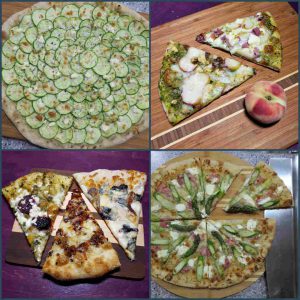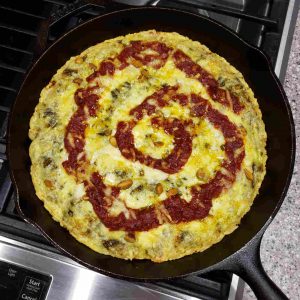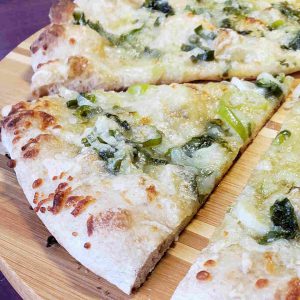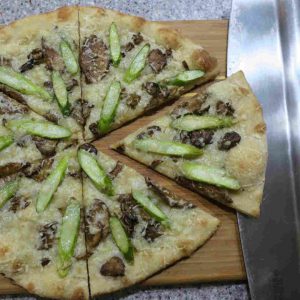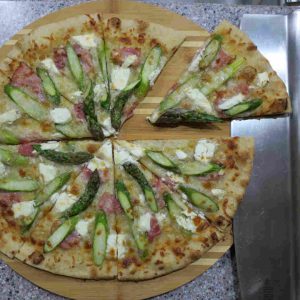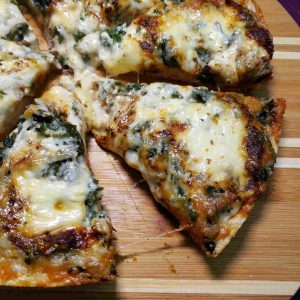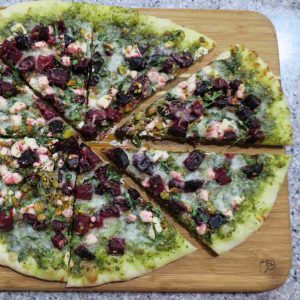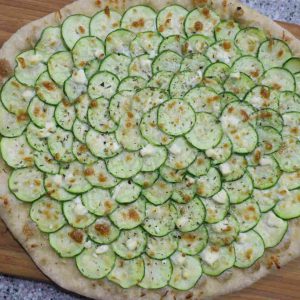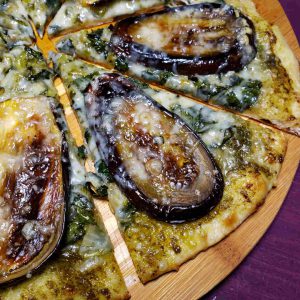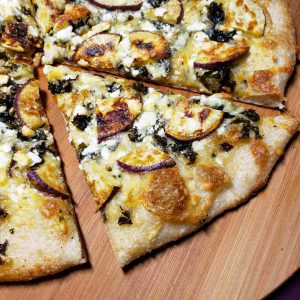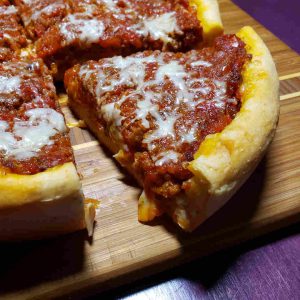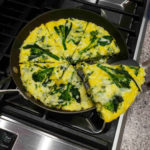Is Pizza a Mother Dish?
For most of my mother dishes, I provide a base recipe. Get the hang of the recipe, and you can exchange ingredients for what’s available local and seasonal. But the options for pizza are so varied, I don’t have a single base recipe. Most of the time, I bake pizza on a baking steel in my home oven. But sometimes I grill pizza and sometimes I use a cast iron pad method. I usually make my dough from scratch, but often I get a really great dough from my local co-op that comes in frozen balls. Sometimes I stretch my pizza dough in a traditional manner, leaving it thick at the rim, so you get a nice, big, chewy crust (what we call pizza bones in our house). Sometimes I use a rolling pin to make the crust uniformly very thin.
So, I don’t have a foundation recipe for pizza, but I still classify it as a mother dish. Pizza was the first dish that I tried to make regularly with seasonal farmers’ market ingredients. Pizza works so well as a vessel for so many different toppings. In this post, I’ll talk about pizza’s big 4 components: the crust, the sauce, the cheese and the toppings. In other posts, I’ll go into more specific baking details.
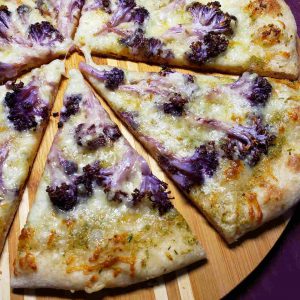
The Crust
Pizza dough, pie dough and stock all have one thing in common. You can make a better version at home than what you can buy at the grocery. But, if the effort of making them from scratch would stop you from making a recipe that requires them, by all means, take the shortcut and get the stuff from the grocery. Don’t let the trouble of making pizza dough from scratch prevent you from enjoying creative pizza options baked in your own kitchen. There are so many crust options available to you.
The simplest options are the pre-made pizza surfaces. Generally, I mean a prebaked crust. Most pre-baked pizza crust options are pretty blah, but there are exceptions. Boboli is a half-way decent example. Better than pre-baked pizza crusts is naan. If you have a decent naan, you can turn it into pizza pretty quickly, even in a toaster oven. And remember when French bread pizza was a thing? It was a thing because it’s pretty good. It’s still an option. You can also find prepared grain-based gluten free pizza crusts. And, for avoiding grains, you can find prepared cauliflower crusts.
From there, you can up your pizza game a notch by purchasing fresh dough balls. This leaves you with the responsibility of rolling out the dough and the magic of having it bake in your own oven. Most pizzerias will sell balls of their own dough. Buy them the day you want to cook. Many grocery stores sell frozen pizza dough balls, and many of those are pretty good. My local co-op makes a great pizza dough which they sell frozen. It’s convenient to have pizza dough balls in the freezer, and I use them often. Follow the thawing directions that come with the dough balls.
Making Your Own Dough
The next step from buying pizza dough balls is to make them yourself. I do have a method that works for me, but there are SO MANY nuances which have their effects, I don’t want to say my way is right for you. If you want to make your own dough from scratch, and haven’t figured out what works best for you, start with this link: How to Make New York Style Pizza at Home. It’s by one of my favorite food science geeks, J Kenji Lopez-Alt. Of most importance is the first section where Kenji explains why New York style pizza (from a crust perspective anyway) is the best option for the home oven. The next most important is the last section on the science of the dough, including the roles of sugar and olive oil (which are never used in Neapolitan style pizza dough). After that, here are 3 links for you:
- Kenji’s New York Style Pizza Dough
- Alton Brown’s Last Pizza Dough Recipe (another one of my favorite food science geeks!)
- Jim Lahey’s No Kneed Pizza Dough Recipe
I’d recommend starting with either Kenji’s or Alton’s dough recipe. They are pretty similar. Jim’s recipe lacks the olive oil and sugar. If you watch the video at that link, they use a broiler to get the pizza stone to 659°F (just 3 seconds into the video). That takes a well behaved oven, and some comfort to work at such high heat. Anyway, select your dough recipe, and then each of the 3 links offer a different method to bring the dough together. I’ve used all three, and they all work. Kenji’s recipe calls for a food processor. It’s pretty cool, but make sure you have a large processor for a full recipe. If you scroll down to the comments in that post, you’ll see testimonials about burnt out food processors. I can say from experience, it locked up my Cuisinart Pro Custom 11. I tried twice, and both times ended up with a sticky mess. Luckily I didn’t try to force things and hence I didn’t burn out the motor. Having said that, I’ve succeeded with the food processor technique when I cut the recipe by a third, yielding 2 dough balls instead of three. As long as your food processor is up to the volume of the recipe, it’s a great option. Alton’s method requires a stand mixer. Jim’s method requires absolutely no special equipment, and it’s amazing that it actually works with no kneading!
The Sauce

In 1993, I had the Big Star pizza at Lilly’s Pizza in Raleigh, North Carolina, in the 5 Points district. It totally changed my perception of what pizza could be. No red sauce. Pesto. And the toppings included gorgonzola cheese, roasted red peppers and pistachios. Now, when I make pizza at home, I rarely use red sauce. I rely on various pestos and quick infused olive oils.
For pesto, there’s the classic: basil, garlic, Parmesan, pine nuts, salt and olive oil. But, the herb, cheese and nuts are all very flexible. Besides basil, I like to make pesto with arugula, stinging nettle, carrot tops and garlic scapes. Besides Parmesan, I really like to use a local cheese called Calvander done in the aged Asiago style. Besides pine nuts, I often use pistachios, pecans, or walnuts.
For quick infused olive oil, the idea is to chop up something aromatic, heat it in a couple tablespoons of olive oil, let it bubble a bit, but not brown. Then take it off heat and let things infuse further as the oil cools. Spread this around the base of a pizza, and you have a nice layer of flavor on which to build. Garlic and rosemary are two favorites for this, but I’ve been known to use shallots, oregano, sage and thyme.

The Cheese
In general, I like to use good cheeses, sparingly. Instead of loads of mild mozzarella, consider a smaller amount of gouda or Gruyère. If you have a local cheese maker that offers some nice, melty cheeses, consider supporting them and make pizzas with a flavor profile that is unique to your area.
Remember that Big Star pizza from Lilly’s that I mentioned above? Besides learning about pesto as a sauce, I also learned that cheese itself can be a topping. The Big Star has a nice blend of cheeses as a base, but the chunks of gorgonzola are spread around the pizza just like a topping. Judicious amounts of robustly flavored cheeses, selected to complement the other toppings, can really complete a pizza. Along with all of the cheeses under the blue cheese umbrella, fresh goat cheese, funky taleggio, and young (firm) brie are all interesting options.
The Toppings
The topping flexibility is why I say pizza is a mother dish. A crispy crust with a flavorful base and delicious cheese, there are so many things that can be tasty on top. Any season of the year, there’s something coming out of the garden or available at the farmers’ market, that you can make the star of a pizza. Pizza was the first mother dish I played with, long before I had the idea of calling them mother dishes. I decided that, for a full year, I would make at least one pizza a month that used some combination of farmers’ market ingredients. It turns out that by the end of that year I had made pizza with almost 40 combinations of toppings. As I remember, none of them were bad, but some were certainly better than others.
The Combinations
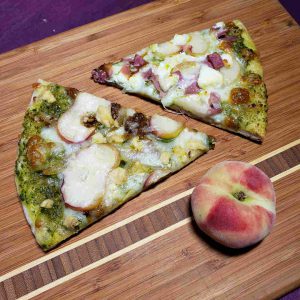
When you are making pizza with seasonal toppings, you get to wield your creative side. You have to consider the whole pizza. Some sauce, cheese and topping options will clash. Others form a symphony. You want each part to be nice, but you really want the pizza to be more than the sum of its parts. Back to Lilly’s Big Star as an example, basil pesto, roasted red peppers, gorgonzola and pistachios. Individually, these are all good parts. Together, they are a symphony.
For creative guidance, look to flavor combinations that you’ve been introduced to in restaurants that were surprisingly good together. If they work with some bread on the side, they’ll likely work as a pizza. For example, long ago we selected “Beet Carpaccio” from a menu as an appetizer. It was paper-thin sliced, roasted beet served on a bed of arugula topped with fresh goat cheese and pistachios. It was delicious. And it turned out to be a favorite pizza combination. Start with an arugula pesto using a generous amount of pistachios. Layer on just a bit of mild cheese to act as a glue. Layer on thinly sliced roasted beets on top of that, and finish with a bunch of dabs of goat cheese. Yum.
Another thing I love to do is to surprise people with sweet and savory on top of a pizza pie. Peaches, prosciutto, and chèvre. Peaches, Italian sausage and gorgonzola. Figs, gorgonzola and walnuts. Muscadine, bacon, pecans and chèvre. Pears, walnuts and brie. My favorite sauce options for sweet and savory combinations are basil pesto and rosemary infused olive oil.
As time goes on, I’ll post pizza ideas that work out well, along with the details of how to make them yourselves. In the meantime, here’s a gallery with a bunch of other ideas for you!

